Cruising Cape Verde, the Canaries & Madeiran Archipelago - Part I
Good evening everyone. It’s good to be back! I hope everybody is feeling well and making the most of glorious weather we are experiencing – well, at least it’s a sunny day down here in East Kent. For the last blog, I wrote about my five weeks cruising up and down the Nile. This time, I have just returned from almost a month aboard ‘Hebridean Sky’, taking her on two cruises. The first saw us island-hopping in Cape Verde and the Canaries, whilst the second took us from the Canaries, via Madeira, to Portsmouth. It felt wonderful to be back on the ocean wave for the first cruises of the season for ‘Hebridean Sky’, and I thought I would write a blog to cover the islands that we visited. The twelve islands we docked or anchored at were, chronologically: Santiago, Fogo, Santo Antão, São Vicente, São Nicolau, Sal (all Cape Verde); La Palma, La Gomera, El Hierro, Tenerife (all Canaries); and Madeira and Porto Santo (both Madeira). I’ll split the islands in two and write about the first six now, and then the second six in a further blog.
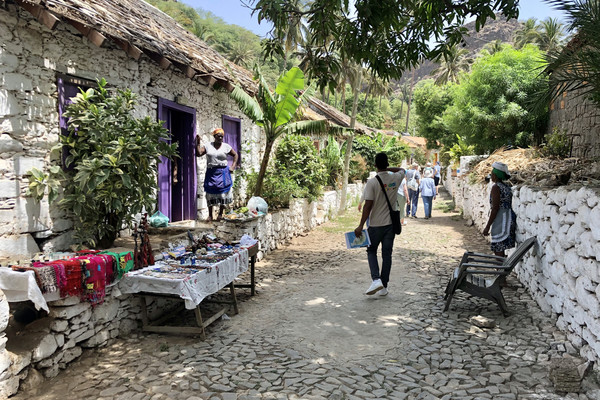
Rua Banana in Cidade Velha on Santiago, the oldest settlement in Cape Verde. 9th April 2022.
I wrote three separate blogs about the Cape Verde archipelago back in October 2020. All three are still available if you scroll down to the bottom of this screen. They detailed my previous visit to the islands back in 2015 on ‘Hebridean Sky’. I was thrilled to have the chance to return 6½ years later on the same ship, and see how things had or hadn’t changed. The most striking difference was the time of year of the visit. The rainy season in Cape Verde is from July to mid-October. My previous visit had been in late October and the landscape had been green and lush in many places. On this occasion, understandably the landscape was much drier and having compared my photos, the contrast is quite distinct. We landed at the airport near Praia, on the island of Santiago, and everyone treated the ship as though they were seeing an old friend again. I, perhaps, felt this more than most as my assistant, Fiona, has been a close friend for 15 years and had sailed with the ship to have everything ready as she repositioned from Seville to Cape Verde. After a few months away, it felt wonderful to walk up the gangway and be able to get back to doing what we do best. We stayed alongside the first night, to guarantee a good night’s sleep after our direct charter flight from Gatwick, and then we headed out to explore Santiago the next day.
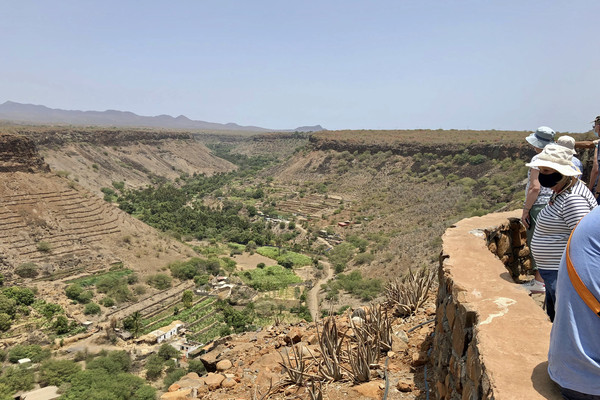
Looking down from the fort into the vast valley housing the Ribeira Grande de Santiago stream on Santiago. 9th April 2022.
Santiago is a must-visit of the Cape Verdean islands, particularly as it is where the human story of the islands starts. We began in Praia itself, with a visit to the interesting Ethnographic Museum, with articles helpfully written in English as well as the widely-spoken Portuguese. Our walk in the town continued through the brightly coloured market, passing the neat squares, and into the main church. A young lady was practicing on the impressive church organ when we arrived, and her shyness immediately caused her to stop. I persuaded our guide to ask her to continue, and when she did, it filled the church with a carnival of beautiful music. We then looked down on ‘Hebridean Sky’ in the harbour before being driven to the original capital of Cape Verde – Cidade Velha. Enthusiastic ladies demonstrating their local ‘Batuku’ dance welcomed us at a generous refreshment stop before we walked along to the UNESCO-listed area which includes Rua Banana in the first photo above. I paused at the stall in front of the house with purple frames, with the intention of buying a particular souvenir. She didn’t have the one I wanted, but an extremely colourful necklace caught my eye, and I wore it for the rest of our time in Cape Verde. A service was taking place in the historic Our Lady of the Rosary Church, which, having been constructed in 1495, is the oldest colonial church in the world. The singing echoed out through the open doors and it was delightful to just be able to pause for a moment and listen. We then headed up above Cidade Velha to visit the 16th century Forte Real de São Filipe, from whose entrance the photo above is taken from. The fort was beautifully restored twenty years ago and the views are outstanding. With our visit to Cidade Velha complete we ascended the mountain roads of Santiago to indulge in a buffet lunch with stops at various viewpoints on the way up and down.
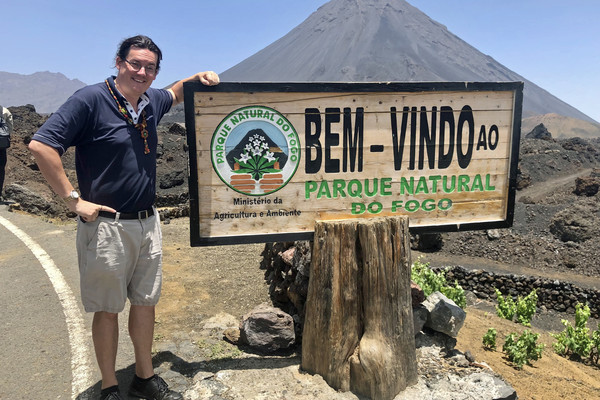
Welcome back to Fogo! 10th April 2022.
The following morning, we anchored off the island of Fogo, the most south-westerly of the islands we were to visit. This was the island I was most looking forward to. When I visited in 2015, it was only a year since the volcano that dominates the island had erupted. I was fascinated to see what it would be like seven years later. Noble Caledonia has a strong link to Fogo, as after that 2014 eruption the Noble Caledonia Charitable Trust donated money so that the school bus service could still be operated in the affected areas. Having safely landed ashore by zodiac, our mini-coaches took us on a tour of the island. The scenery was charming and varied, and a few stops were made. However, I knew in the back of my mind that once we reached the welcome sign, pictured above, everything would change. I was sat alongside the driver of the vehicle, and as we continued on from the welcome sign, I made a point of turning round to see the faces of the passengers. Every single one became open-mouthed as the power of nature and magnitude of what happened on this small Atlantic island came into view.
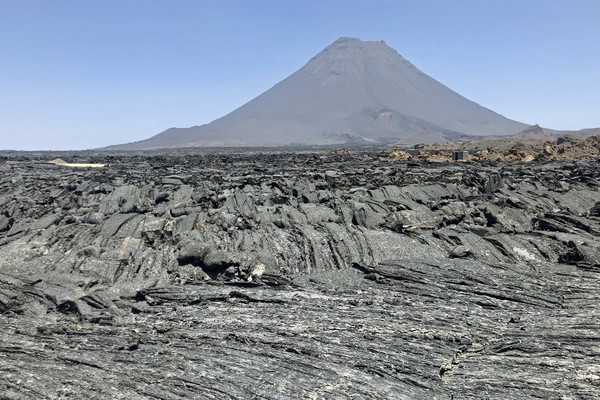
A landscape like no other. Inside the huge caldera on Fogo. 10th April 2022.
Our driver paused on the cobbled road which has been newly laid (or at least since I last visited) across the lava field so that we could step off the vehicle to take a photo as shown above. If you look carefully, you can see the white rooftop of a building on the left, which is all that remains of somebody’s home. The other thing to remember is that whilst we see the ‘new’ volcano in the distance, we are well inside the epic crater left by the original volcano. With the possible exception of Santorini, I don’t think I have ever been anywhere that illustrates the destructive power of nature more than Fogo. And while Santorini is now a dormant story, Fogo is very much still alive. The incredible scenery continued as we made our way to a restaurant that had only opened the previous day on my last visit. Now it has rightly become a thriving business, specialising in Fogo wines, and a delicious lunch was enjoyed by all. A pause was made in Fogo’s main town on the way back to the harbour, with the chance to sample the local elderly baker’s homemade treats. We then said farewell to Fogo and headed north on the longest sea passage within the archipelago. The islands are laid out in a reversed ‘C’ shape, and so we were going to spend the night sailing from one end of the ‘C’ to the other.
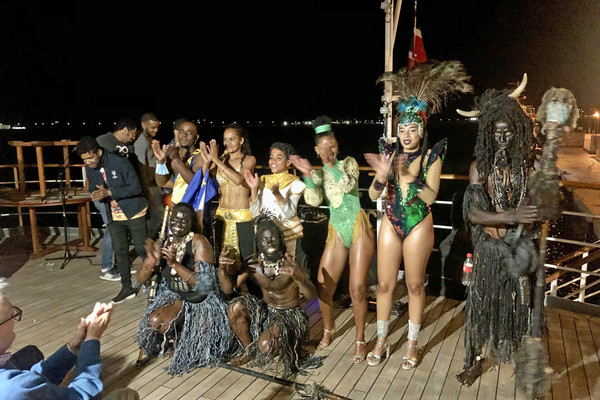
Carnival Night on board ‘Hebridean Sky’ in São Vicente. 11th April 2022.
The following morning we woke up to find we were alongside on the island of Santo Antão. Our main local agent, a wonderful lady called Isaneth, sailed on board with us to ensure that all the arrangements were taken care of on the various islands. It is such an asset to have someone like Isaneth on board who can react to any situation. She was born and raised on Santo Antão and keen to show off her home island to the passengers. The island is mountainous with stunning vistas, including the village of Fontainhas which appears to perilously cling to the hillside. It does make one wonder why they chose to build in the most awkward of locations. The island also presented us with the opportunity to try the local ‘grogue’ and we enjoyed taking the mountain route to the far side of the island, but then the contrasting coastal route back to the harbour. Meanwhile, the busy ferry had been running back and forth between Santo Antão and neighbouring São Vicente, and we followed the same route during the evening so that we were safely ensconced in Mindelo harbour towards the end of dinner. Whilst the passengers were dining, I was glad to have the opportunity to do something that hasn’t been possible in recent years, and invite a local show to perform on board. As with all former Portuguese territories, they are steeped in carnival tradition, and Cape Verde is no exception. São Vicente would argue that it has the most popular carnival on these islands, and we rearranged the Lido into a theatre style and enjoyed live music and dancing from an incredibly energetic and enthusiastic troupe. A superb evening under the stars.
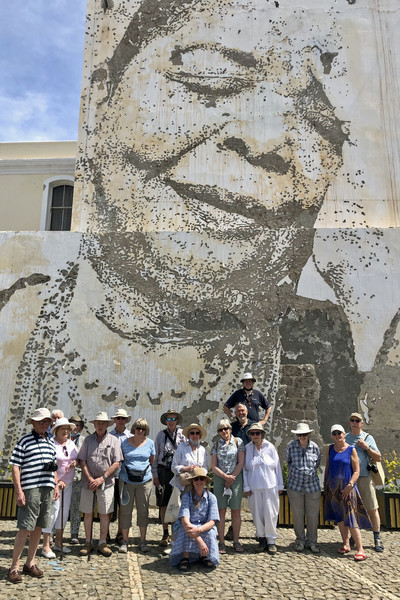
The clever artwork of Cesária Évora in Mindelo, with me and my group of passengers. 12th April 2022.
After our overnight in the port, we spent a full day exploring Mindelo. In Cape Verde, we use ‘Coaster’ vehicles, which have a capacity of around 14 passengers. It’s rather fun to have this fleet of vehicles nipping around the various sights, thereby ensuring we don’t all arrive at the same place at the same time, and with only a maximum of 14 of us on board, nowhere is crowded. I can’t begin to imagine what a ‘big ship’ would do in Cape Verde. The only sensible and proper way to truly explore the archipelago is on a ship of our size, and with our accompanying local agent. Our exploration of Mindelo included a guitar workshop, with a superb demonstration of traditional Cape Verdean music. We then strolled through the fish market – which was interesting as all of the people on the stalls were women. The men catch and process the fish, and the women sell it. We continued through the clean and tidy streets and passed by the huge mural shown above, cleverly created by plastering a wall and then chipping away to form the image of legendary Cape Verdean singer Cesária Évora. After meandering the streets we enjoyed a welcome refreshment break in a charming courtyard café with gentle live music. The waitresses were all in smart uniforms, and I mentioned to a passenger that it strongly reminded me of being in Cuba. Said passenger had been with us on a Cuban cruise and replied that that was exactly the same thoughts they’d been having. Suitably refreshed, we continued to another market, the main square (featuring a bandstand made with Glaswegian iron) and finally the Cultural Centre. Temptation proved too much in the Cultural Centre and I played their concert grand, with two of our passengers surprising me by singing along in harmony. It was a surprise to realise that we had fitted all of this into just a morning, and yet not felt rushed at any time. There is a reason that the motto of these islands is, “no stress”.
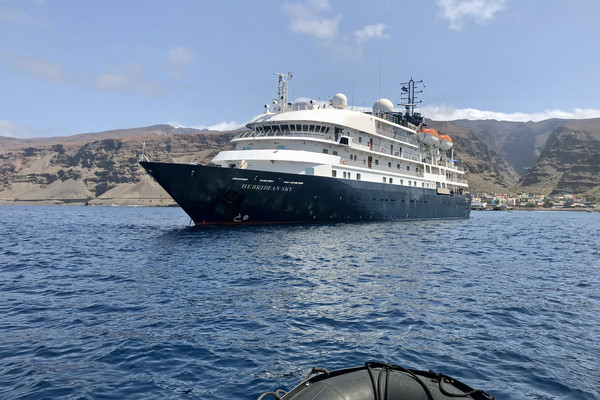
‘Hebridean Sky’ at anchor off São Nicolau. 13th April 2022.
After lunch on board we ran multiple shuttle buses so that the passengers could choose to return to the town or enjoy a swim at the nearby golden sandy beach. The following morning, we arrived at the island of São Nicolau. As can occasionally happen, the ferry had unexpectedly been delayed and so our berth was not available. Whilst this would be a disaster for a large ship, for us it simply meant we dropped anchor, lowered the zodiacs, and went ashore via the more fun option instead! The tour in São Nicolau is split, with half of the passengers going in the morning, and the other half in the afternoon. Once Dr Chris Edwards, Louis Justin and I had ferried the morning passengers ashore for their tour, we felt it was a shame to not make the most of this unexpected anchorage, and so we offered zodiac trips for all the afternoon passengers as well. Egrets abounded and a sea turtle made a surprise appearance next to my zodiac. Why is it that the unplanned events always bring the most joy! I joined the afternoon tour which headed up a beautifully smooth road to the island’s capital, tucked away high in the hills. The reason that the majority of the islands’ capitals are inland is because of the frequent pirate attacks of years gone by. The ports were deliberately built in such a way that they could be easily rebuilt, whilst the main defences were placed around the harder to reach settlements in the hills.
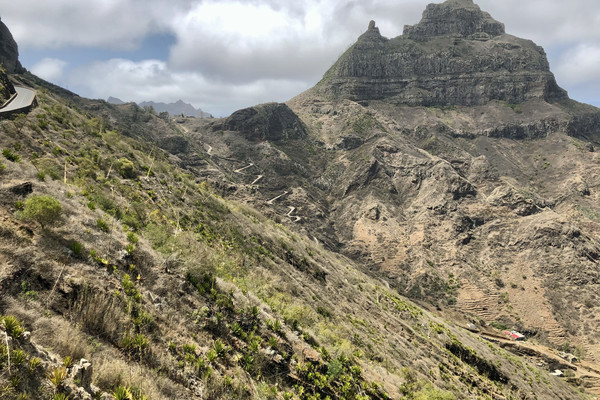
A scenic viewpoint in São Nicolau, showing the old winding road in the centre. 13th April 2022.
Our first stop was a pause at the viewpoint shown above. You can see the smooth new road on the left, which we were using, and then the twisting original mountain road in the centre. I know which I prefer! We reached the island’s capital, Ribeira Brava, and walked around the centre. It is one of those places where the friendly locals are just as intrigued to see us as we are to see them. A welcome coffee break was accompanying by an enthusiastic singer and guitarist, and then it was time to continue the tour of this island which is much less-visited by tourists than others.
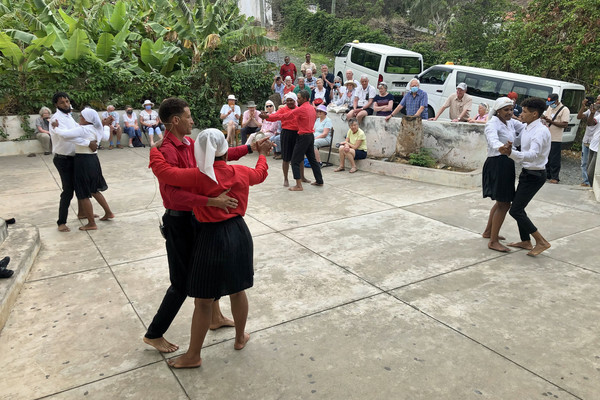
A performance of Cape Verdean ‘Mazurka’ in a remote village on São Nicolau. 13th April 2022.
Our journey through São Nicolau reached a village where four couples performed a demonstration of the traditional Cape Verdean dance, Mazurka. As a pianist, I couldn’t help but think of Poland and Frédéric Chopin – and indeed the rhythm is the same. Interestingly, during the dance where the lead chap was giving out instructions, he did so in French. They danced beautifully, and as you can see, the entire performance was barefoot. This did, however, lead to some amusement as one of the dancers had left their two small children to sit quietly while they performed. Being small children, this was always going to be something of a challenge – and so to entertain themselves, the children tried on all the shoes belonging to the performers whilst they were dancing. I think it’s fair to say that they stole the show! Another highlight was the drive back to the ship after the Mazurka. It coincided with the end of the school day, and we passed smart-looking school children of all ages walking back to their homes. Without exception, they all smiled and waved at us as we drove by, and we smiled and waved back. Sometimes the world really is a happy place, and a smile and a wave can make all the difference.
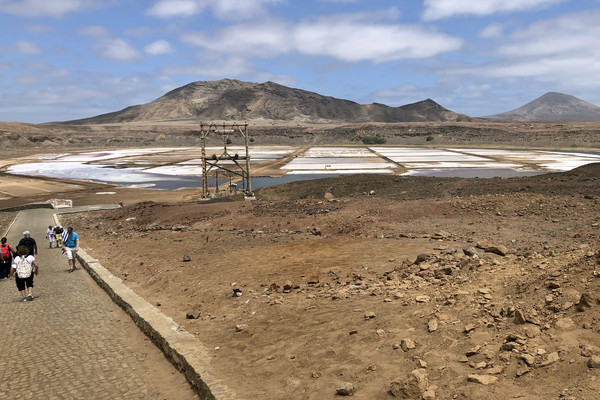
The vast salt pans within the caldera on the island of Sal. 14th April 2022.
Our final island on our Cape Verde trip was Sal – and a complete contrast to all the others we had visited. Whereas the others are mountainous and volcanic, Sal is one of the three easternmost islands (along with Boa Vista and Maio) which are fairly flat, sandy and dry. Our morning tour took us to Pedra de Lume, which was established in 1805 to harvest salt. The French-Senegalese operated business lasted until 1984, but now only some locals use it for salt production. However, the caldera has gained a second wind and it is the only place, other than the Dead Sea, that I have known for tourists to be able to float in its waters. If you have never floated on water before, it is an experience I thoroughly recommend. It doesn’t seem real for a while, and then you get used to it and it feels very relaxing. After lunch back on board, the afternoon offered the chance to have free time in Sal’s seaside resort of Santa Maria, and spend any remaining Cape Verde Escudos before our two days at sea to the Canary Islands. My bet is that if you were to say to somebody that you were going to Cape Verde, I would guarantee that the overwhelming majority would presume you were going to Sal and staying in a beach resort. However, that would do a grave injustice to Cape Verde. The archipelago is one I could never get tired of exploring. Whilst the scenery is spectacular, the human history is fascinating too. Their motto of “no stress” is exactly the thought that springs to mind. The Cape Verdeans are rightly very proud of their archipelago. ‘Hebridean Sky’ will be returning to Cape Verde in early November this year, after the rainy season has finished, and I am thrilled that I will be on board again. To see the contrast from the pre-rainy season to the post-rainy season will be very interesting. Then in April next year, there is the opportunity to explore eight of the nine inhabited islands on a dedicated Cape Verde cruise. If you haven’t been, then I cannot recommend it highly enough. A big thank you to all the passengers for making it such a memorable trip, as well as my team of Fiona, Caroline, Isabel, Chris and Louis. Thank you for reading!
Click here to view details of our small ship cruises to Cape Verde





